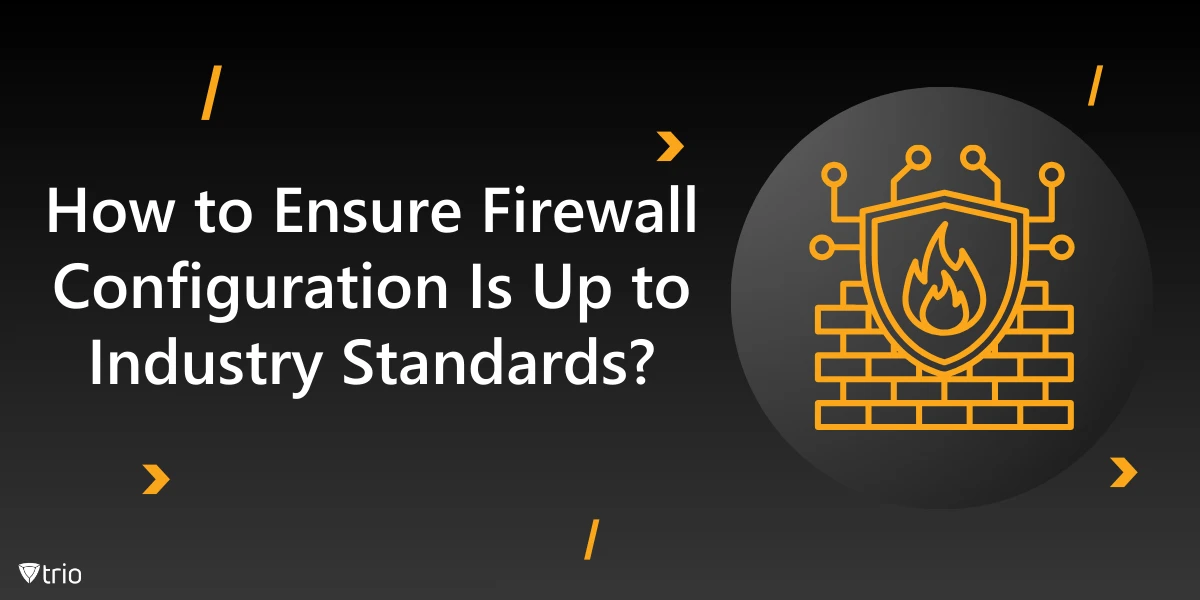In today’s interconnected digital landscape, securing your organizational network from cyber threats is paramount. Firewalls, the first line of defense against malicious traffic, play a crucial role in safeguarding your internal network. However, a misconfigured firewall can inadvertently create vulnerabilities, rendering your network susceptible to attacks. Ensuring your firewall configuration adheres to industry standards is vital to maintaining a robust security posture. This comprehensive guide delves into the intricacies of firewall configuration, best practices, and strategies to fortify your network defenses.
Understanding the Significance of Firewall Configuration
Firewall configuration is the process of setting up and managing the rules that govern how a firewall system handles incoming and outgoing network traffic. These rules determine which types of traffic are allowed or denied access to your internal network, ensuring only authorized communications pass through. Proper firewall configuration is essential for safeguarding your organization’s sensitive data, intellectual property, and critical infrastructure from cyber threats such as malware, distributed denial-of-service (DDoS) attacks, and unauthorized access attempts.
Adhering to Industry Standards: A Proactive Approach
Numerous organizations, including the International Organization for Standardization (ISO) and the National Institute of Standards and Technology (NIST), have established comprehensive guidelines and frameworks for firewall configuration. These industry standards provide a robust foundation for securing your network firewalls, addressing various aspects such as firewall policy, inbound and outbound traffic management, stateful packet filtering, network address translation (NAT), access control lists (ACLs), and virtual private network (VPN) integration.
Aligning your firewall configuration with these industry-recognized standards not only enhances your security posture but also ensures compliance with regulatory requirements specific to your industry. Compliance with standards like the Payment Card Industry Data Security Standard (PCI DSS) is crucial for organizations handling sensitive financial data, as it helps mitigate the risk of data breaches and associated penalties.
Implementing Robust Firewall Rules and Rulesets
At the core of effective firewall configuration lie well-defined firewall rules and rulesets. These rules dictate how the firewall should handle network traffic, controlling access to subnets and ensuring a secure internal network. While specific rules may vary based on your organization’s unique requirements, several fundamental principles should be followed:
- Deny All by Default: Implement a “deny all” rule as the default stance, denying all traffic unless explicitly allowed. This approach minimizes the risk of unauthorized access and potential denial-of-service attacks.
- Principle of Least Privilege: Allow only the necessary network connections based on IP addresses, denying everything else. This principle ensures secure access to network devices and services, reducing the attack surface.
- Explicit Allow Rules: Define explicit rules that allow specific network traffic based on source and destination addresses, types of service, TCP/UDP protocols, and authentication mechanisms.
- Stateful Inspection: Employ stateful inspection firewalls that monitor the state of active network connections and use this information to determine which network packets to allow through the firewall. This approach enhances security by tracking and managing the flow of traffic.
Regularly reviewing and updating your firewall rules and rulesets is crucial to maintain an effective security posture. As your organization’s network evolves, new services or applications may require adjustments to the existing rules to ensure seamless operations while maintaining robust protection.

Firewall Configuration Best Practices
In addition to adhering to industry standards and implementing robust firewall rules, adopting best practices for firewall configuration can further fortify your network’s defenses. These practices encompass various aspects of firewall management, including:
Regular Firewall Audits and Penetration Testing
Conducting regular firewall audits is essential to identify potential misconfigurations, policy changes, or deviations from industry standards. These audits can help ensure your firewall device is functioning optimally and highlight areas for improvement. Furthermore, subjecting your firewall to periodic penetration testing can simulate real-world cyber-attack scenarios, allowing you to assess the robustness of your defenses and identify vulnerabilities that require immediate attention.
Implementing a Comprehensive Firewall Policy
A well-defined firewall security policy serves as the cornerstone for effective firewall management. This policy should govern all aspects of firewall configuration, including router configurations, remote access protocols, gateway security, and incident response procedures. Regularly reviewing and updating this policy ensures it remains aligned with industry best practices and your organization’s evolving security requirements.
Utilizing Advanced Firewall Solutions
Modern firewall solutions offer advanced features that can significantly enhance your security posture. Solutions like Trio MDM (Mobile Device Management) provide unparalleled visibility into your network infrastructure, enabling in-depth firewall configuration analysis and proactive threat detection. By leveraging such advanced solutions, you can streamline security management, protect against sophisticated threats like distributed denial-of-service (DDoS) attacks, and maintain compliance with industry regulations.
Centralized Firewall Management and Monitoring
In organizations with multiple firewalls deployed across various locations, centralized firewall management and monitoring can streamline operations and ensure consistent configuration across all devices. Centralized management tools enable efficient policy distribution, real-time monitoring, and automated reporting, reducing the risk of misconfigurations and enhancing overall security.
Comprehensive Logging and Auditing
Maintaining comprehensive logs and audit trails is crucial for effective firewall management. These logs provide valuable insights into network traffic patterns, potential security incidents, and firewall performance. Regular log analysis can help identify anomalies, detect unauthorized access attempts, and inform necessary adjustments to your firewall configuration.
Robust Access Controls and User Management
Implementing robust access controls and user management practices is essential to mitigate the risk of internal threats. Restrict administrative access to your firewall to only authorized personnel, enforce strong password policies, and implement multi-factor authentication (MFA) for added security. Additionally, regularly review and update user accounts to ensure only active and authorized users have access to your firewall systems.
Backup and Disaster Recovery Strategies
Regularly backing up your firewall configurations and maintaining a robust disaster recovery strategy is crucial for ensuring business continuity in the event of a security incident or system failure. Periodic testing of your backup and recovery processes can help identify and address any potential issues, minimizing downtime and ensuring a seamless restoration of your firewall systems.
Firewall Configuration Commands and Examples
To effectively configure and manage your firewall, it is essential to understand and utilize various firewall configuration commands. These commands enable you to define rules, manage access control lists (ACLs), configure network address translation (NAT), and perform various other tasks. Here are some common firewall configuration commands and examples:
Configuring Access Control Lists (ACLs)
Access control lists (ACLs) are a fundamental component of firewall configuration, allowing you to define rules that permit or deny specific types of traffic based on source and destination IP addresses, protocols, and port numbers. Here’s an example of configuring an ACL:
ip access-list extended ACL_NAME
permit tcp host SOURCE_IP host DEST_IP eq PORT_NUMBER
deny ip any any
In this example, the first line creates an extended ACL named ACL_NAME. The second line allows TCP traffic from the specified SOURCE_IP to the DEST_IP on the specified PORT_NUMBER. The third line denies all other traffic by default.
Configuring Network Address Translation (NAT)
Network Address Translation (NAT) is a technique used to map private IP addresses to public IP addresses, enabling internal devices to communicate with the internet while maintaining security. Here’s an example of configuring NAT:
ip nat inside source static PRIVATE_IP GLOBAL_IP
interface ethernet0/0
ip nat inside
interface ethernet0/1
ip nat outside
In this example, the first line maps the PRIVATE_IP to the GLOBAL_IP for NAT translation. The subsequent lines define the ethernet0/0 interface as the inside interface (private network) and the ethernet0/1 interface as the outside interface (public network).
Configuring Firewall Interfaces
Firewall interfaces define the boundaries between different security zones, such as the internal network, external network, and demilitarized zone (DMZ). Configuring these interfaces correctly is crucial for ensuring proper traffic filtering and security. Here’s an example:
interface ethernet0/0
security-level 100
ip address INTERNAL_IP SUBNET_MASK
interface ethernet0/1
security-level 0
ip address EXTERNAL_IP SUBNET_MASK
In this example, the ethernet0/0 interface is configured as the internal interface with a security level of 100 and an IP address from the internal network. The ethernet0/1 interface is configured as the external interface with a security level of 0 and an IP address from the external network.
Configuring Firewall Policies
Firewall policies define the rules that govern how traffic is handled between different security zones. These policies can be configured based on various criteria, such as source and destination IP addresses, protocols, and port numbers. Here’s an example:
access-list POLICY_NAME extended permit tcp any host DEST_IP eq PORT_NUMBER
access-group POLICY_NAME in interface ethernet0/1
In this example, the first line creates an access control list named POLICY_NAME that permits TCP traffic to the specified DEST_IP on the specified PORT_NUMBER. The second line applies this policy to the ethernet0/1 interface for inbound traffic.
These are just a few examples of firewall configuration commands. The specific commands and syntax may vary depending on the firewall vendor and platform you are using. It is essential to consult the documentation and guidelines provided by your firewall vendor to ensure proper configuration and compliance with industry standards.

Modifying Firewall Settings: A Step-by-Step Guide
Modifying firewall settings is a critical task that should be approached with caution and a thorough understanding of the potential impacts on your network’s security. Here’s a step-by-step guide to help you modify your firewall settings while adhering to industry best practices:
- Document the Current Configuration: Before making any changes, document your current firewall configuration, including all rules, policies, and settings. This documentation will serve as a reference point and aid in troubleshooting or rolling back changes if necessary.
- Assess the Need for Change: Carefully evaluate the reason for modifying your firewall settings. Identify the specific security requirements, compliance mandates, or operational needs that necessitate the change.
- Review Industry Standards and Best Practices: Consult relevant industry standards, such as those published by NIST or ISO, as well as best practices from reputable sources, to ensure your proposed changes align with recommended guidelines.
- Test in a Controlled Environment: Whenever possible, test your proposed firewall configuration changes in a controlled environment, such as a staging or testing network, before implementing them in your production environment. This step will help identify and mitigate potential issues or conflicts before they impact your live systems.
- Implement Changes with Proper Authorization: Ensure that you have the necessary authorizations and follow established change management processes before implementing any firewall configuration changes in your production environment.
- Monitor and Validate: After implementing the changes, closely monitor your firewall logs and network traffic patterns to validate that the new configuration is functioning as intended and has not introduced any unintended consequences or security vulnerabilities.
- Document and Communicate Changes: Thoroughly document the changes made to your firewall configuration, including the rationale, impact assessment, and any additional notes or observations. Communicate these changes to relevant stakeholders, such as network administrators, security teams, and end-users, to ensure awareness and alignment.
- Establish a Rollback Plan: Develop a clear rollback plan in case the new firewall configuration causes unexpected issues or disruptions. This plan should outline the steps necessary to revert to the previous configuration quickly and efficiently, minimizing downtime and potential security risks.
- Schedule Regular Reviews and Audits: Implement a schedule for regular reviews and audits of your firewall configuration to ensure ongoing compliance with industry standards and best practices. This proactive approach will help identify and address potential misconfigurations or vulnerabilities before they can be exploited.
Firewall Configuration for Home and Small Office Networks
While enterprise-level firewall configurations are often complex and require dedicated resources, home and small office networks also benefit from proper firewall configuration. Many modern routers and networking devices come equipped with built-in firewall capabilities, allowing you to enhance the security of your home or small business network. Here are some tips for configuring firewalls in these environments:
Enable the Firewall
The first step is to ensure that the firewall feature is enabled on your router or networking device. Most modern routers come with a built-in firewall that can be activated through the device’s web-based configuration interface or mobile app.
Configure Port Forwarding
If you need to access specific services or applications from the internet, such as a web server or remote desktop connection, you may need to configure port forwarding on your firewall. Port forwarding allows incoming traffic on specific ports to be directed to a specific device on your internal network.
Disable Remote Administration
For enhanced security, it is recommended to disable remote administration of your router or networking device from the internet. This feature can be a potential entry point for unauthorized access if not properly secured.
Enable Wireless Security
If you are using a wireless network, ensure that you enable wireless security features, such as WPA2 encryption and a strong password. This will help prevent unauthorized access to your network and protect your data from potential eavesdropping.
Update Firmware
Regularly check for and install firmware updates for your router or networking device. These updates often include security patches and bug fixes that can help protect your network from known vulnerabilities.
Firewall Configuration and Network Security: An Ongoing Process
Ensuring your firewall configuration adheres to industry standards is not a one-time task but an ongoing process. As cyber threats evolve and new vulnerabilities emerge, it is crucial to regularly review and update your firewall configuration to maintain a robust security posture. Here are some key considerations for ongoing firewall management:
Stay Informed About Emerging Threats and Vulnerabilities
Regularly monitor industry news, security advisories, and vendor updates to stay informed about emerging threats, vulnerabilities, and recommended security patches or configuration changes. This proactive approach will help you identify and address potential risks before they can be exploited.
Implement a Change Management Process
Establish a well-defined change management process for firewall configuration modifications. This process should include steps for documenting proposed changes, testing in a controlled environment, obtaining proper approvals, implementing changes, and validating the new configuration.
Conduct Regular Security Assessments and Audits
Engage in regular security assessments and audits to evaluate the effectiveness of your firewall configuration and identify potential areas for improvement. These assessments can include vulnerability scans, penetration testing, and compliance audits to ensure your firewall configuration meets industry standards and regulatory requirements.
Leverage Centralized Firewall Management Tools
In larger organizations with multiple firewalls deployed across different locations, consider implementing centralized firewall management tools. These tools can streamline the configuration process, ensure consistent policies across all firewalls, and provide real-time monitoring and reporting capabilities.
Foster Collaboration and Knowledge Sharing
Encourage collaboration and knowledge sharing among your security teams, network administrators, and other stakeholders. This collaborative approach can help identify potential configuration issues, share best practices, and ensure a cohesive understanding of your organization’s security posture.
Continuous Training and Professional Development
Invest in continuous training and professional development for your IT and security personnel. As firewall technologies and security best practices evolve, it is essential to ensure your team has the necessary skills and knowledge to effectively configure and manage your firewalls.
The Role of Trio MDM in Ensuring Firewall Configuration Compliance
Organizations often face challenges in maintaining consistent and compliant firewall configurations across their entire network infrastructure. Trio MDM (Mobile Device Management) offers a comprehensive solution to streamline firewall configuration management, ensuring adherence to industry standards and enhancing your overall security posture.
See Trio in Action: Get Your Free Trial Now!
Trio MDM is a powerful platform that provides centralized control and visibility over your organization’s mobile devices, servers, and network infrastructure. By leveraging Trio MDM’s advanced capabilities, you can effectively manage and monitor your firewall configurations, ensuring they remain up-to-date and compliant with industry best practices.
To experience the power of Trio MDM and explore how it can revolutionize your firewall configuration management, we invite you to request a free demo. Our experts will guide you through the platform’s features and help you understand how Trio MDM can elevate your organization’s security posture to new heights.




